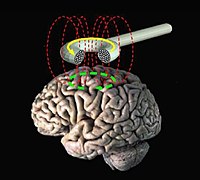
Photo from wikipedia
Background It is increasingly acknowledged that the outcomes of medical treatments are influenced by the context of the clinical encounter through the mechanisms of the placebo effect. The phenomenon of… Click to show full abstract
Background It is increasingly acknowledged that the outcomes of medical treatments are influenced by the context of the clinical encounter through the mechanisms of the placebo effect. The phenomenon of placebo analgesia might be exploited to maximize the efficacy of neurorehabilitation treatments. Since its intensity varies across neurological disorders, the Italian Consensus Conference on Pain in Neurorehabilitation (ICCP) summarized the studies on this field to provide guidance on its use. Methods A review of the existing reviews and meta-analyses was performed to assess the magnitude of the placebo effect in disorders that may undergo neurorehabilitation treatment. The search was performed on Pubmed using placebo, pain, and the names of neurological disorders as keywords. Methodological quality was assessed using a pre-existing checklist. Data about the magnitude of the placebo effect were extracted from the included reviews and were commented in a narrative form. Results 11 articles were included in this review. Placebo treatments showed weak effects in central neuropathic pain (pain reduction from 0.44 to 0.66 on a 0–10 scale) and moderate effects in postherpetic neuralgia (1.16), in diabetic peripheral neuropathy (1.45), and in pain associated to HIV (1.82). Moderate effects were also found on pain due to fibromyalgia and migraine; only weak short-term effects were found in complex regional pain syndrome. Confounding variables might have influenced these results. Clinical implications These estimates should be interpreted with caution, but underscore that the placebo effect can be exploited in neurorehabilitation programs. It is not necessary to conceal its use from the patient. Knowledge of placebo mechanisms can be used to shape the doctor–patient relationship, to reduce the use of analgesic drugs and to train the patient to become an active agent of the therapy.
Journal Title: Frontiers in Neurology
Year Published: 2018
Link to full text (if available)
Share on Social Media: Sign Up to like & get
recommendations!